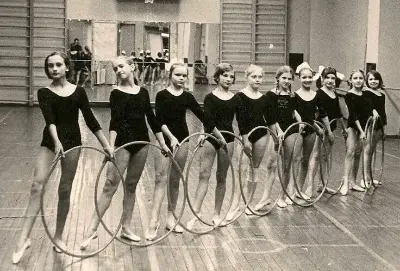90 years of rhythmic gymnastics and its development
Rhythmic gymnastics, one of the most beautiful Olympic sports, was created back in 1934 at the "Higher School of Artistic Movement" named after P.F. Lesgaft in Leningrad (now St. Petersburg). This event involved well-known studios of that time, such as Zinaida Verbova's School of Plastic Arts, the plastic department of Alexandra Semenova-Naipak's "Temas" studio, the Petrograd Institute of Rhythm, Elena Gorlova's Studio of Artistic Movement, and many others. It was at the Higher School named after P.F. Lesgaft that the first lessons took place, and the main subject of special training for students was named "rhythmic gymnastics". It was there that the Leningrad pedagogues determined the full volume of the program material of this sport, and the very first competition rules were developed.
The first rhythmic gymnastics competition was held in 1939 in Leningrad. The competition took place within the framework of personal superiority in the free program and was dedicated to International Women's Day on March 8.
The first Master of Sports in rhythmic gymnastics was Liliya Nazmutdinova from

Over time, the most aesthetic sport has developed, the rules have been improved, and in 1967, the first World Championship took place in Copenhagen, where group exercises were taken into account. In 1978, a regular European Championship in rhythmic gymnastics was established, initially held, like the World Championship, every two years, and since 1992 - annually.

After the Moscow Olympics in 1980, the International Olympic Committee included rhythmic gymnastics in the program of the following Olympic Games. Thus, in 1984, the first Olympic competitions in rhythmic gymnastics took place in Los Angeles, but only in individual exercises. Since 1996, starting from the Olympic Games in Atlanta, group exercises have been included in the competition program.
A separate mention deserves the World Cup in rhythmic gymnastics, held in Tokyo in 1985. Then, for the first time in history, a men's team performed in this sport. Western guests did not particularly like this performance, but Japanese viewers were delighted. Soon, a separate championship in men's gymnastics was established, where Russians appeared only in 2005, winning 5 medals at once.

Over 90 years of its existence, rhythmic gymnastics has undergone significant changes in technique and performance style. Modern gymnasts combine elegance, flexibility, and strength in their performances, performing complex elements and combinations of movements. The introduction of the Code of Points scoring system in 1989 was an important step in the development of rhythmic gymnastics, establishing clear assessment criteria and standards for the execution of elements.
rhythmic gymnastics continues to develop and introduce new elements and techniques to amaze spectators with its graceful performances. It remains one of the most popular and inspiring sports at the Olympic Games and other international competitions.





























































